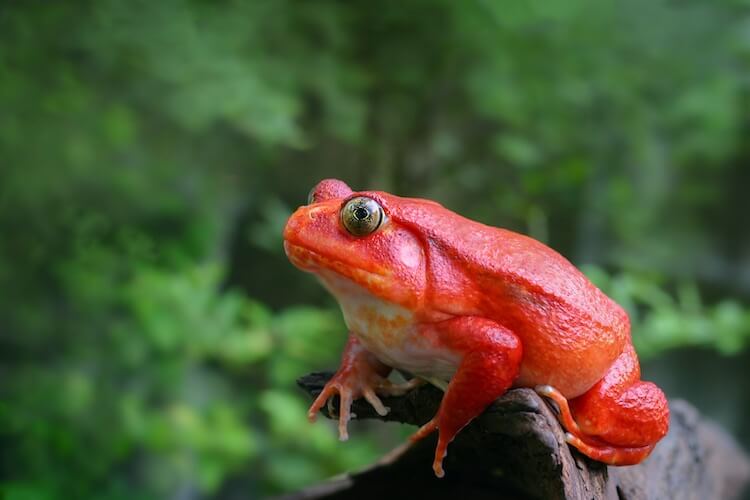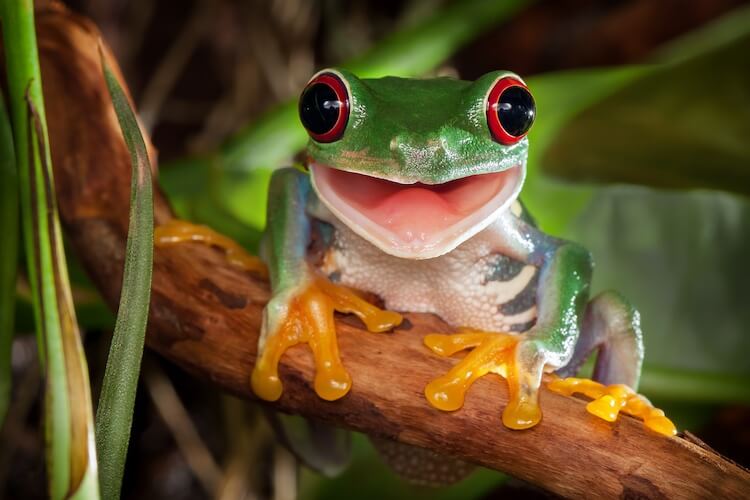Picture this: a small, vibrant creature hopping around in an enclosure at your home. It’s not a rabbit or a bird, but a pet frog. Now imagine the surprise when you discover these little amphibians have dietary preferences beyond what we traditionally think – yes, ‘Pet Frogs That Don’t Eat Bugs.’
Wild pet frogs mainly eat bugs. Domesticated pet frogs and exotic species have a diverse diet. This article will discuss these interesting creatures and correct common myths about what they eat.
Why Do Frogs Eat Bugs?
Contrary to popular belief, not all frog species are into bugs! Weird as it may seem, some best pet frogs turn their noses up when they see a bug scurrying by. This is best exemplified by certain terrestrial frogs like the African Clawed Frog, which often favors small fish, shrimp, and tadpoles over bugs for their meals. Pet owners want to cater to their pets’ nutritional needs without trekking outdoors in the dark with a flashlight hunting down insects.

Frogs choose bugs for several reasons, nutritional value being the key one. Bugs come packed with proteins and other vital nutrients, including fat, which are strong energy sources for these amphibians. This can vary significantly depending on species type – terrestrial or aquatic, as mentioned earlier – and each has evolved different dietary preferences reflecting their distinctive habitats and lifestyles.
Are There Any Pet Frogs That Don’t Eat Bugs At All?
Venturing into the exquisite world of pet frogs, you might be shivering right now at the thought of feeding them a daily diet of creepy crawlies. The leaf-litter frog from Central and South America is a unique specimen among anuran species (frogs and toads) as it primarily feasts on plant matter. This departure from the usual insectivorous tendencies presents intriguing possibilities for maintaining these amphibians as pets.
Your adventurous inclination towards keeping frogs that don’t eat bugs could find a fascinating and satisfying solution with leaf-litter frogs. You may surprisingly discover your newfound uninhibited kinship with these creatures while observing their eating habits, shedding light on remarkable deviations in evolutionary biology underpinned by varying dietary preferences across species!
2 Pet Frogs Don’t Eat Bugs
African Dwarf Frogs and Vivacious Tomato Frogs. Apart from their unusual diets, the most notable thing about these creatures is the sheer joy and fascination they bring into a home. The aquatic African Dwarf Frogs are (fish-eaters) by nature. They ditch bugs for a protein-rich regimen mainly consisting of small fish and specialized frog pellet food you can find at your nearest pet store.

On the other hand, our colorful tomato frogs prefer non-buggy meals like earthworms or soft pellets specially made for amphibians over any run-of-the-mill insect. They are genuinely fascinating pets, turning heads not just with their eye-catching beauty but also with their exceptional meal preferences!
African Dwarf Frog
Explore the fascinating world of the African Dwarf Frog, a rare pet frog that doesn’t eat insects. This small water-loving creature spends most of its time underwater, making it an excellent choice for aquarium lovers or those looking for a unique addition to their fish tank. Best frogs for pets, these little ones prefer to eat bloodworms, brine shrimp, and pelleted frog food. This makes them an excellent choice for pet owners who don’t like dealing with bugs.
You can even feed them by hand without worrying about bugs crawling on you! Watching them sneak up on their food is fun, just like they would in the wild rivers of Sub-Saharan Africa. Each African Dwarf Frog has its personality – some are shy, while others are more outgoing. Their funny behaviors will keep you entertained.
African Clawed Frog
This species can be an intriguing choice for those seeking pet frogs who don’t eat bugs, offering you a fantastic respite from the usual dietary demands of most amphibian pets. These aquatic creatures prefer small fish, worm-like invertebrates, and detritus and will even relish the occasional cheeky bite of commercial frog pellets or frozen bloodworms!

Transforming reptilian pet keeping into an enchanting experience is what the African Clawed Frog does best! Not only are they fascinating to observe, but their easy maintenance and non-buggy diet make them an ideal choice for first-time frog owners and seasoned herpetologists looking for something distinct. Their unique clawed toes and exquisite skin texture promise countless hours of captivating observation as you venture through your journey with pets that don’t need insects!
How Do You Feed Aquatic Frogs?
Feeding aquatic frogs is a fascinating topic, especially for those who cringe at the idea of handling bugs. Yes, you read right! You can nurture frogs who don’t eat bugs and maintain a healthy diet. Their biologically diverse systems enable them to flourish on alternative diets, so they are perfect pets for people who shudder at the prospect of feeding live insects.
:strip_icc()/frog-540812_1920-5c44db86c9e77c00013c2f1d.jpg)
An optimal diet staple for these amphibious creatures includes frozen or freeze-dried foods like brine shrimp and bloodworms. A note of caution here: avoid overfeeding as this can significantly impact water quality in their habitat, potentially leading to ill health. Setting this balance may seem challenging initially, but it becomes an engaging learning journey about your unique pet’s needs and nature’s clever intricacies.
Final Thoughts
Pet frogs that don’t eat bugs offer a unique and exciting alternative for those who seek an unusual pet without dealing with the often bothersome task of bug handling. These types of frogs, such as the African Dwarf Frog or the White’s Tree Frog, can thrive on a diet primarily consisting of pellet food, making them more accessible and easier to care for than their bug-eating counterparts. This allows more people to experience the joy and fascination of owning a pet easy frog. So, if you are considering getting a new exotic pet, consider these amphibious options. Dare to explore beyond traditional choices and take home your bug-free frog today!